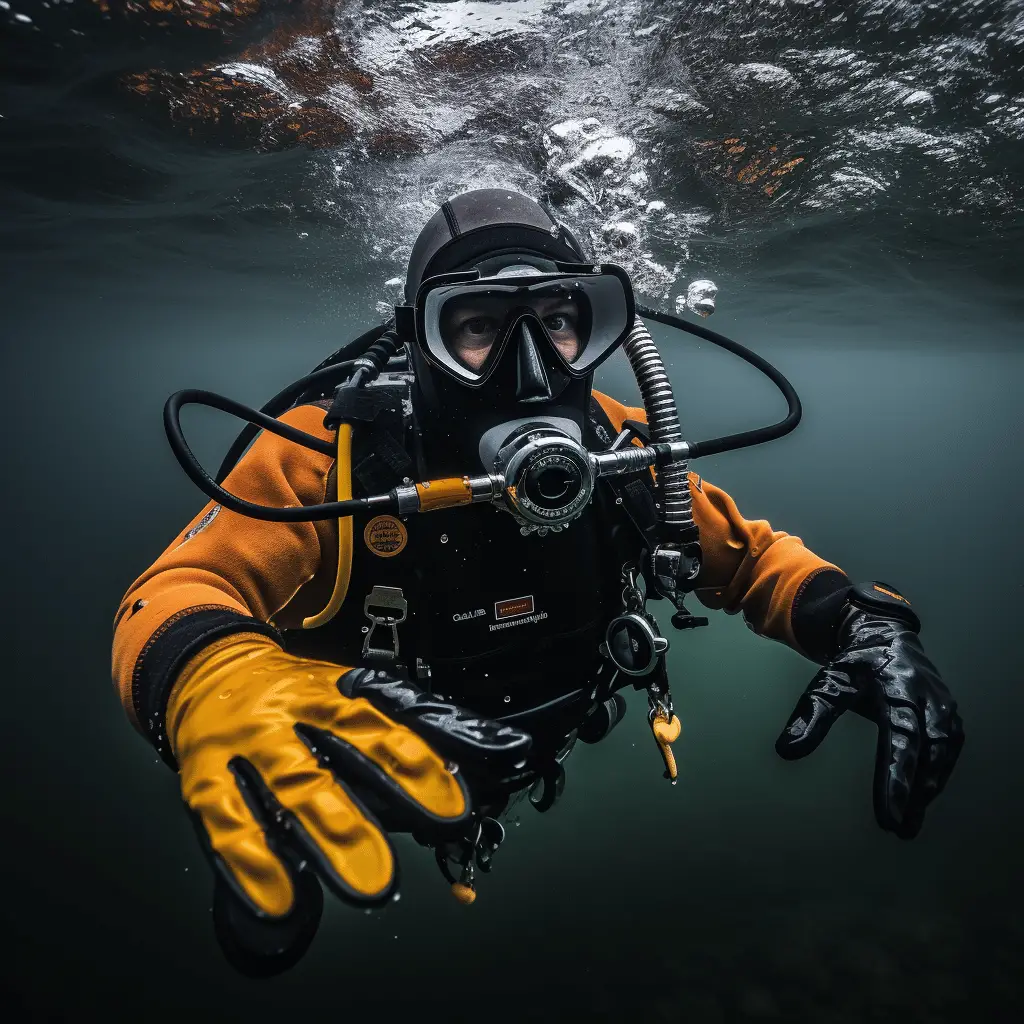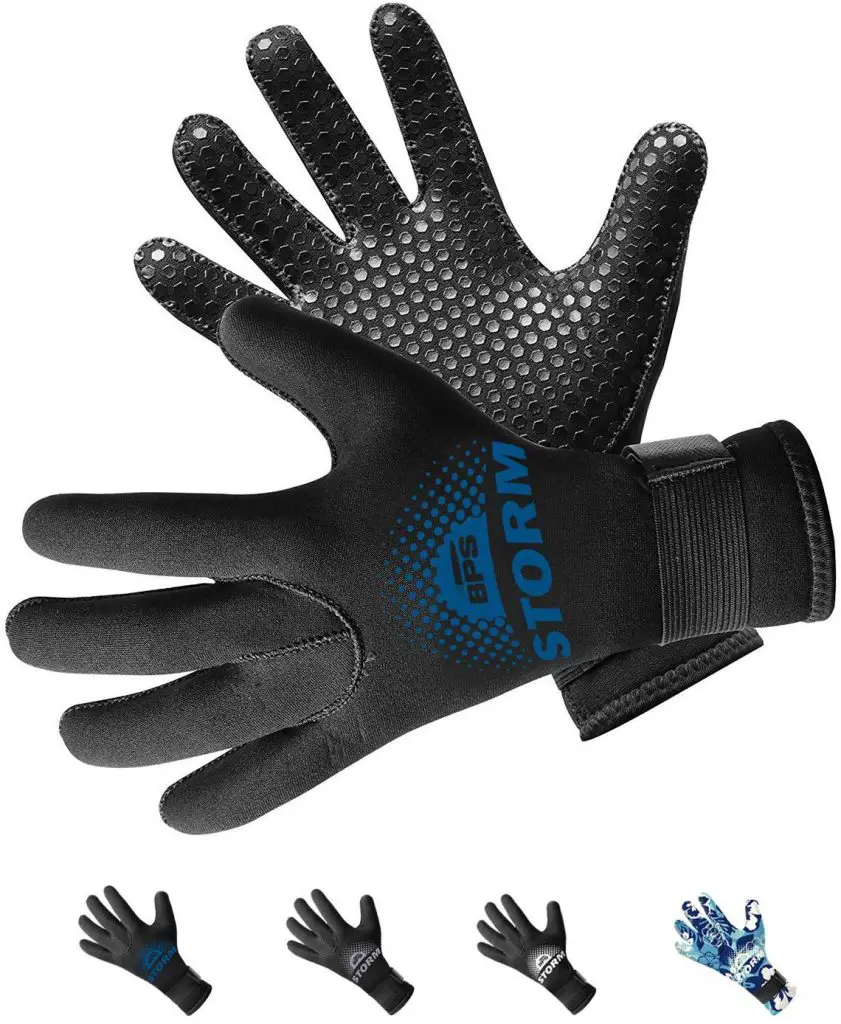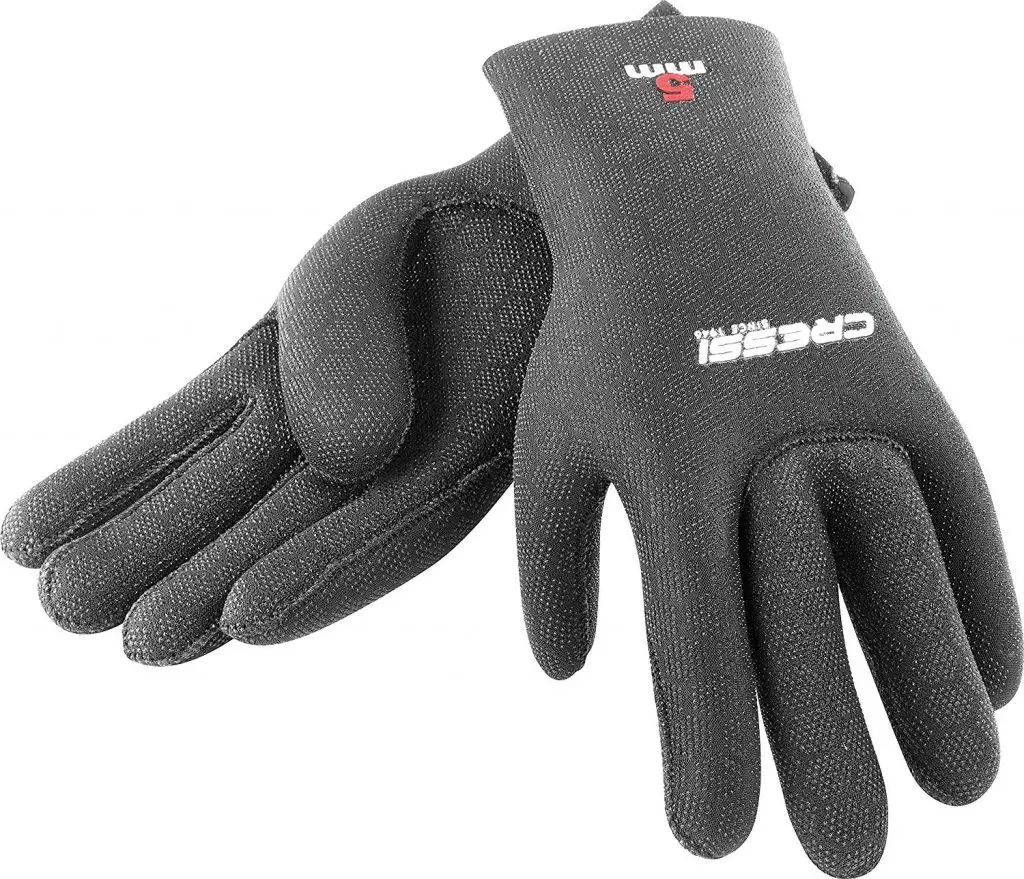Diving gloves are essential safety gear when taking a plunge. It keeps your hands well-insulated, especially if you’re diving in cold and deep waters. Aside from that, diving gloves also shield your skin from sharp objects that you may encounter underwater. We scouted 3 of the scuba diving gloves for cold water out of the market’s hundreds of options for this post. See which one suits you well based on features, price, and overall value.
Unlike other diving gloves, those made for low temperatures are thicker. This is to trap body heat within your skin and to serve as a cushion against various objects.
| GLOVE | BRAND | EXPERT RATING | CHECK PRICE |
|---|---|---|---|
 | NeoSport 5mm Neoprene Wetsuit Gloves |  | |
 | BPS Double-Lined Wetsuit Diving Gloves |  | |
 | Cressi Neoprene Stretch Diving Gloves |  |
Why use scuba diving gloves for cold water?
Scuba gloves are made for a good reason: to protect your hands. Diving in cold water is no joke; your hands will go numb within minutes if you don’t wear any protection. It’s important to shield as much skin as you can when you’re plunging into the sea, especially on deep dives.
Aside from that, you may encounter sharp objects and even fish fins during your dive. If your hand is exposed, you’re at risk of sustaining injuries. Worse, some marine life has poison and sting that may put you at risk. The last thing you want to happen is aborting the dive due to a sea wasp bite or exposure to stonefish.
[BUYING GUIDE] Scuba Diving Gloves for Cold Water

If you’re looking for scuba diving gloves for cold water, you must look for the following features first:
-Choose the right thickness
When it comes to diving gloves for cold water, you need to find the thickest one. We recommend a 5 mm to 6.5 mm glove for optimal warmth and protection. This thickness is ideal for temperatures between 10C to 18C. For warmer temperatures of 16C to 24C, 2 mm to 5 mm gloves would do. The colder the water is, the thicker your gloves should be.
-Get the right material
Next, you should check the material of the diving gloves you’re planning to buy. Nowadays, there are two types of materials used on this gear.
**Textile
Textile is the most common material since it’s thinner and easy to use underwater. However, textile gloves are ideal for shallow dives and warmer temperatures. It does great in protecting your hands against sharp objects, but it doesn’t have the best thermal protection.
Amara is the most common textile used in this type of diving gloves. It’s durable and comfy to use. If you’re a hardy diver, you can use this glove for as low as 15C. However, we don’t recommend doing so since you stand the chance of getting your hands numb.
**Neoprene
When it comes to cold water dives, we swear by thick neoprene gloves. Unlike textiles, neoprene has better insulation characteristics. You can also find neoprene gloves in a wide range of thickness, sometimes as thin as 0.5 mm or as thick as 7 mm.
Also, neoprene diving gloves are often reinforced with textured material to improve their grip.
-Fit it right
Once you’ve chosen the right material and thickness for your diving gloves, you have to get the right fit. Always choose a comfortable fit that doesn’t squeeze your hand too much. You should be able to make hand signals with the glove on.
If the glove doesn’t feel comfortable when you’re on land, it would be difficult to use underwater when the pressure is factored in.
Avoid very small gloves since your hand will force the stitches and may cause the seams to unravel. When this happens, water will seep through and make your hand cold.
On the other hand, very big diving gloves will trap water inside, which will defeat the purpose of wearing one.
-Select the right style
There are two styles of diving gloves: five-finger and mitten-style.
Five-finger diving gloves give you the freedom to move your hands and make signals underwater. This is also the standard option among divers, although it’s a tad less more warm than mitten-style gloves. Also, it looks like a normal glove.
On the other hand, mitten-style diving gloves have a large pocket where you fit all your four fingers and a separate area for your thumb. For beginners and even many seasoned divers, this type of glove is very difficult to use. It limits your hand movements and may not be ideal if you’re using hand signals with your buddies.
So why are mitten-style gloves popular? Many use it due to its better insulation. The mitten construction makes your hand warmer. Still, the trade-off here is the ease of movement.
-Get enough insulation
Neoprene gloves offer the best insulation during cold dives. It would help if you also got a pair of gloves that fit correctly – not too tight and not too loose. You need the material to stick to your skin the whole time to prevent water and cold temperature from creeping in.
-Check the glove dexterity
One of the most important things you have to check is the dexterity of the glove. This refers to how well you can move your fingers and hands while the glove is on. A pair of gloves with excellent dexterity will let you manipulate your gears with minimal effort.
Also, you need a glove with excellent dexterity so you can communicate with your buddies. We always recommend five-finger gloves, especially on deep dives. Mitts have the least dexterity, though it lets you make the ‘OK’ sign easily. Although it will keep your hands warm, it also limits you from using your gears.
How to care for your diving gloves
To make your diving gloves last long, you must store and maintain them properly. Here are some of our personal recommendations:
*Rinse it after each dive. Saltwater is very abrasive. Letting your gloves dry with seawater will cause them to fade and crack easily. Make sure that you soak and rinse it with fresh water before storage.
*Wash it with wetsuit shampoo. If you have to wash your wetsuit, use shampoo. It’s gentle on the suit and it removes salt from gloves really well. It also helps cleaning other muck that has gotten into it.
*Air-dry it. It’s never a good idea to machine-dry your diving gloves. Just let it flat on a drying rack, but don’t put it under direct sunlight.
*Keep it in a dry place. Once your gloves are washed and dried, store them in a dry and cool place.
Additional safety tips
*Check your gloves first. Before you take a dive, make sure that your gloves are in good shape. If there are holes or unraveling seams, we recommend getting a new pair first.
*Wear a thick pair of gloves. Never dive in cold water without a thick pair of gloves. You can’t risk having your hands numb, especially if you’re staying underwater for long.
*Don’t improvise with fabric gloves. If you’re thinking of using typical gloves, you should think twice. Fabric gloves offer no insulation, plus they will only absorb water, which will make your hands as cold as not wearing any protection.
3 Scuba Diving Gloves for Cold Water
OUR #1 CHOICE
[wp-review id=”138″]
RUNNERS-UP
[su_service title=” BPS Double-Lined Wetsuit Diving Gloves ” icon=”icon: star” icon_color=”#2D3092″ size=”32″ class=””][/su_service]

If you want excellent texture all over the palms, we recommend the BPS Double-Lined Wetsuit Diving Gloves. Like the pair from Neo Sport, this one from BPS has an adjustable wrist strap so you can keep the pair in place. It has double-lined neoprene to provide the best warmth while you dive. It will also minimize the water that gets into your hand.
You can quickly move your hands-free with these gloves. It has excellent dexterity that reduces fatigue while you’re underwater. Aside from that, these gloves have a glued and stitched construction that’s made to last.
We really like these diving gloves because it’s available in a wide range of sizes. Even if you have large hands, you can find a pair that suits you well.
All the diving gloves from BPS are covered with their ‘next-level’ warranty of 12 months. If there are quality issues, you can demand a replacement or refund based on your liking. These gloves can be considered a good pair of cold water diving gloves.
A bonus part here is that the BPS gloves are available in colorful prints. You can get in green camo, floral pink, floral blue, and more. Overall, these gloves are ideal for all water activities.
[su_row class=””] [su_column size=”1/2″ center=”no” class=””][su_box title=”PROS” style=”noise” box_color=”#115F23″ title_color=”#FFFFFF” radius=”8″ class=””] ✔️Suitable for water and winter sports ✔️Doubled lined neoprene ✔️12-month warranty [/su_box][/su_column] [su_column size=”1/2″ center=”no” class=””][su_box title=”CONS” style=”noise” box_color=”#B20010″ title_color=”#FFFFFF” radius=”8″ class=””] . ❌A little stiffer than most . . [/su_box][/su_column] [/su_row]
[su_service title=” Cressi Neoprene Stretch Diving Gloves ” icon=”icon: star” icon_color=”#2D3092″ size=”32″ class=””][/su_service]

For those who have the budget for a premium pair of scuba diving gloves for cold water, we recommend the Cressi Neoprene High-Stretch Gloves. It’s a five-finger pair with high-stretch neoprene that provides unbeatable dexterity underwater.
The gloves’ insides are lined with Metallite, so it’s easy to put on and off. Meanwhile, the outer layer has a non-slip finish so that you can grip any object. It also protects against abrasions and tearing. However, it would help if you avoided contact with Velcro surfaces so the tiny dots all over the gloves won’t come off.
We also like that this has semi-bent fingers to mimic the natural curve of your hands. It’s comfy and warm, something we don’t’ find surprising from the Cressi brand. This pair also keeps the circulation in your hands, even on high-pressure dives. Just make sure that you get the right size.
These gloves are designed in Italy and are produced by one of the pioneer brands in watersports. Its excellent grip makes it a very versatile choice.
The Cressi diving gloves are available in 2.5 mm, 3.5 mm, and 5 mm. For cold water diving, we recommend that you get the thickest option.
[su_row class=””] [su_column size=”1/2″ center=”no” class=””][su_box title=”PROS” style=”noise” box_color=”#115F23″ title_color=”#FFFFFF” radius=”8″ class=””] ✔️Metallite lining for comfortable wearing ✔️High-stretch neoprene ✔️Excellent dexterity [/su_box][/su_column] [su_column size=”1/2″ center=”no” class=””][su_box title=”CONS” style=”noise” box_color=”#B20010″ title_color=”#FFFFFF” radius=”8″ class=””] . ❌You have to be careful with the dotted grips . [/su_box][/su_column] [/su_row]
Frequently Asked Questions
Q: Can I dive without gloves?
A: You can, but you’ll be exposed to various hazards underwater. For example, if you’re diving in 12C water, your hands will go numb within 10 minutes if you’re not wearing any protection. Also, your hands may get wounded, especially if you’re diving on wreckages or coral reefs.
In some areas, wearing gloves is a standard protocol by most professional divers. One purpose of the gloves is to keep debris from being transferred onto the diver’s hand from contact with marine life or other detritus on the ocean floor.
In addition to protecting you against germs and urchins, there are practical reasons for wearing gloves underwater as well. Gloves protect your hands against urchin’s spines and can increase warmth when out of the water into colder water environments where insulation may be useful. Wearing gloves also allow you better dexterity with gear movements in which fingers are important such as releasing buckles and adjusting straps. Gloves offer protection from cuts but diminishing sensation as they can make fingers less sensitive to their precise location.
Q: How often should I replace my diving gloves?
A: It depends on how worn out your gloves are. If you’re diving regularly and noticing intense pilling or the stitches coming off, it might be time to replace your pair. It would be best if you looked for durable diving gloves, so they will last for months or years before you need a replacement.
Diving gloves are not designed to last forever. The rubber will eventually harden and crack, leading to costly repairs or replacement garments. Ideally, you should be replacing your diving gloves every 6-8 months if they are used daily for prolonged periods of time in an abrasive environment. Some manufactures recommend every 3-6 months, depending on usage. If the ducts have become ripped at all, it’s important to replace them sooner than later before any tears can occur in the material that could lead to water seeping into the glove, which is very dangerous for divers. Allowing a tear in this area would result in loss of buoyancy, which leaves your diver vulnerable to injury from sudden depth changes and decreases stability.
Q: If I used a thick glove, wouldn’t it affect my hand movements?
A: Diving into cold water can be a little tough on the hands. It would help if you made sure that your gloves have good dexterity but also maintain their thickness and warmth, so you don’t get too painful after multiple hours of use in rough seas or from pulling out debris while looking for coral polyps
The input explains why divers should choose specific types of scuba gear based on what they plan on doing with it; however, when I read through this passage again, there seems nothing special about them other than being waterproof, which is something everyone needs.
Q: How will I know if the diving gloves would be comfortable underwater?
A: Get the right size! Your diving gloves should feel like an extension of your body. Before you go on a major dive, we recommend trying it out for shallow and shorter plunges to see how they fit before undertaking anything more serious with them snorkeling. If this doesn’t sound like what you need, then maybe try looking elsewhere as there are plenty of other options available in stores that will suit all types of users.
Q: Why are my diving gloves cracking easily?
A: The reason that your gloves are cracking easily is that the material they’re made out of is a synthetic fiber. This means that it piles and stretches, expanding the fibers in an unstable manner rather than conforming to their original length.
What can you do about this problem? It’s really all about taking care of your equipment. Please don’t leave them wet or exposed to direct sunlight. Store them flat out on a surface where they won’t pick up dirt or dust from the ground if possible, and protect them from light as much as possible by putting something over it when storing it at night–preferably something with a high thread count because textiles also get exposed to more dirt due to the fiber structure of fabrics acting like nets.
Conclusion
Scuba diving gloves for cold water are made to keep your hands safe against freezing temperatures and sharp objects. You must wear a pair whenever you dive, regardless of the water’s temperature and depth. Just remember that diving gloves are available in a wide range of thickness and fit. Get a pair that suits your diving technique and preference.
Have you found your pair of diving gloves already? Share your choice with us in the comment section!
